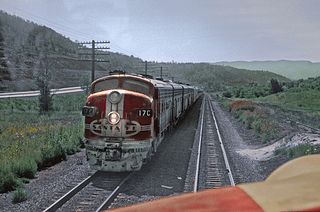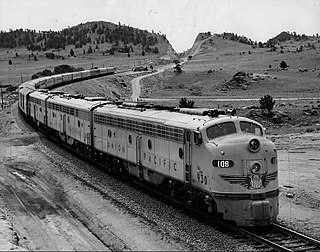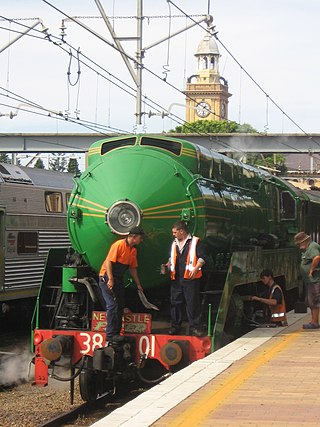
The Chicago, Milwaukee, St. Paul and Pacific Railroad (ACMStP&P), better known as the Milwaukee Road, was a Class I railroad that operated in the Midwest and Northwest of the United States from 1847 until 1986.

The Lake Shore Limited is an overnight passenger train operated by Amtrak between Chicago and the Northeastern United States, with sections to New York City and Boston. The central segment of the route runs along the southern shore of Lake Erie. East of Chicago, the Lake Shore Limited follows the former main line of the Lake Shore and Michigan Southern Railway to South Bend, Toledo, Cleveland, and Buffalo. From here the train takes the Empire Corridor through Rochester and Syracuse to Albany–Rensselaer station in Rensselaer, New York. At that station, the train divides, with one section continuing to Springfield and Boston in Massachusetts, while the other continues along the Empire Corridor to New York City. The train is scheduled for 19+1⁄2–20+1⁄4 hours for the 959 miles (1,543 km) between Chicago and New York, and 21+1⁄2–22 hours for the 1,018 miles (1,638 km) between Chicago and Boston.

The Soo Line Railroad is one of the primary United States railroad subsidiaries for the CPKC Railway, one of six U.S. Class I railroads, controlled through the Soo Line Corporation. Although it is named for the Minneapolis, St. Paul and Sault Ste. Marie Railroad (MStP&SSM), which was commonly known as the Soo Line after the phonetic spelling of Sault, it was formed in 1961 by the consolidation of that company with two other CPKC subsidiaries: The Duluth, South Shore and Atlantic Railway, and the Wisconsin Central Railway. It is also the successor to other Class I railroads, including the Minneapolis, Northfield and Southern Railway and the Chicago, Milwaukee, St. Paul and Pacific Railroad. On the other hand, a large amount of mileage was spun off in 1987 to Wisconsin Central Ltd., now part of the Canadian National Railway. The Soo Line Railroad and the Delaware and Hudson Railway, CPKC's other major subsidiary, presently do business as the Canadian Pacific Railway (CP). Most equipment has been repainted into the CP scheme, but the U.S. Surface Transportation Board groups all of the company's U.S. subsidiaries under the Soo Line name for reporting purposes. The Minneapolis headquarters are in the Canadian Pacific Plaza building, having moved from the nearby Soo Line Building.

The City of Denver was a streamlined passenger train operated by the Union Pacific Railroad between Chicago, Illinois, and Denver, Colorado. It operated between 1936 and 1971. From 1936–1955 the Chicago and North Western Railway handled the train east of Omaha, Nebraska; the Chicago, Milwaukee, St. Paul and Pacific Railroad handled it thereafter. The train was the fastest long-distance train in the United States when it debuted in 1936, covering 1,048 miles (1,687 km) in 16 hours. For almost its entire career its principal competitor was the Chicago, Burlington and Quincy Railroad's Denver Zephyr. When Amtrak assumed operation of most intercity trains in the United States in 1971, it discontinued the City of Denver, preferring to use the Burlington's route between Chicago and Denver.

The Chief was an American long-distance named passenger train of the Atchison, Topeka and Santa Fe Railway that ran between Chicago, Illinois and Los Angeles, California. The Santa Fe initiated the Chief in 1926 to supplement the California Limited. In 1936 the Super Chief was introduced, after the Super Chief was relaunched in 1948 with daily departures from LA and Chicago it gradually eclipsed the Chief as the standard bearer of the Santa Fe because of its timetable oriented to the Raton Pass transit. For some the Chief and San Francisco Chief as deluxe integrated trains with both Pullman sleepers and fully reclining coach seating with all facilities; lounges and pleasure domes, available to all passengers were at least equal flagships better suited to the business and executive market. From the mid 1960s the super Chief was only a small entirely separate section of the El Capitan seated vista train, the El Capitan passengers having no access to the Super Chiefs expensive eateries and bars which selling point was exclusion and service. The Chief was discontinued in 1968 due to high operating costs, competition from airlines, and the loss of Postal Office contracts.

The 400 was a named passenger train operated by the Chicago and North Western Railway between Chicago and Saint Paul, with a final stop in Minneapolis. The train took its name from the schedule of 400 miles between the cities in 400 minutes, and was also a nod to "The Four Hundred Club", a term coined by Ward McAllister to refer to the social elite of New York City in the late 19th century. It was an express train with limited stops between Chicago and the Twin Cities. The "400" ran from 1935 to 1963 on the Chicago to Twin Cities route. The C&NW later named their other passenger trains using the number "400".

The Olympian and its successor the Olympian Hiawatha were passenger trains operated by the Chicago, Milwaukee, St. Paul and Pacific Railroad between Chicago and the Pacific Northwest. The Olympian operated from 1911 to 1947 and was, along with its running mate the Columbian, the first all-steel train to operate in the Pacific Northwest. The streamlined Olympian Hiawatha operated from 1947 to 1961 and was one of several Milwaukee Road trains to carry the name "Hiawatha". The Olympian Hiawatha was designed by industrial designer Brooks Stevens and included the distinctive glassed-in "Skytop" observation-sleeping cars. It later featured full-length "Super Dome" cars.

The Chicago and North Western Class E-4 was a class of nine streamlined 4-6-4 "Hudson" steam locomotives built in 1937 by the American Locomotive Company (ALCO).

The Columbian was a named passenger train operated by the Chicago, Milwaukee, St. Paul and Pacific Railroad between Chicago, Illinois, and Seattle/Tacoma, Washington. The westbound train was Milwaukee Road train #17, and the eastbound train was train #18. It was launched on Monday, May 29, 1911. The same day, the faster, limited-stop and more luxurious Olympian also launched. These were the first passenger trains to take advantage of the Milwaukee Road Pacific Extension, which had opened to freight in 1909.

The Powhatan Arrow was a named flagship passenger train operated by the Norfolk and Western Railway (N&W) in the United States. Debuting on April 28, 1946, the daily westbound No. 25 and the eastbound No. 26 connected Norfolk, Virginia, and Cincinnati, Ohio, covering 676 miles (1,088 km) in about 15 hours and 45 minutes behind streamlined 4-8-4 class J steam locomotives. In late 1949, N&W re-equipped the Powhatan Arrow consist with new lightweight passenger cars, dining cars, and observation cars from the Pullman-Standard Company. It was advertised as the "most beautiful train in the east."

The Challengers were named passenger trains on the Union Pacific Railroad and the Chicago and North Western Railway. The economy service ran between Chicago, Illinois, and the West Coast of the United States. The trains had full Pullman service and coach seating and were an attempt to draw Depression-Era riders back to the rails. Food service was advertised as "three meals for under a dollar a day."
The South Island Limited was a passenger express train operated by the New Zealand Railways Department (NZR) between 1949 and 1970. It operated over the almost 590 kilometres (370 mi) route between Christchurch and Invercargill. It was replaced by the Southerner.

The Twin Zephyrs, also known as the Twin Cities Zephyrs, were a pair of streamlined passenger trains on the Chicago, Burlington and Quincy Railroad (CB&Q), running between Chicago and the Twin Cities of Minneapolis and Saint Paul in Minnesota. It was the second Zephyr service introduced by CB&Q after the record-setting Denver–Chicago "dawn to dusk dash" of the Pioneer Zephyr trainset.

The City of Miami was a seven-car coach streamliner inaugurated by Illinois Central Railroad on December 18, 1940. Its route was from Chicago to Miami a total distance of 1,493 miles (2,403 km).

The Twin Cities Hiawatha, often just Hiawatha, was a named passenger train operated by the Chicago, Milwaukee, St. Paul and Pacific Railroad, and traveled from Chicago to the Twin Cities. The original train takes its name from the epic poem The Song of Hiawatha by Henry Wadsworth Longfellow. There are a number of Hiawatha-themed names within the city of Minneapolis, the terminus of the original train. The first Hiawatha ran in 1935; in 1939 the Milwaukee Road introduced a second daily trip between Chicago and Minneapolis. The two trains were known as the Morning Hiawatha and Afternoon Hiawatha, or sometimes the AM Twin Cities Hiawatha and PM Twin Cities Hiawatha. The Milwaukee Road discontinued the Afternoon Hiawatha in 1970 while the Morning Hiawatha continued running until the formation of Amtrak in 1971.

The Newcastle Flyer was an Australian passenger express train that operated from November 1929 until April 1988 connecting New South Wales' two largest cities, Sydney and Newcastle.

The Minnesota 400 was a streamlined passenger train operated by the Chicago and North Western Railway on its southern Minnesota line between Mankato, Minnesota and Wyeville, Wisconsin. It began running in 1936. In 1950 it was extended to run between Chicago, Illinois and Huron, South Dakota and renamed the Dakota 400. It would be further extended to Rapid City, South Dakota, before being cut back to Mankato, in 1960. This final iteration was named the Rochester 400 and it ceased operation in 1963.

The Peninsula 400 was a daily express passenger train operated by the Chicago and North Western Railway between Chicago and Ishpeming, in Michigan's Upper Peninsula. It operated as a named consist from 1942 to 1969. It was one of the railroad's 400 passenger trains, whose name stemmed from the original '400-mile, 400-minute' express operated by the railroad between Chicago and Minneapolis–St. Paul.
The Chippewa consisting of mostly conventional components, and later known as the Chippewa-Hiawatha, with a streamlined consist was a passenger train operated by the Chicago, Milwaukee, St. Paul and Pacific Railroad between Chicago, Illinois and Michigan's Upper Peninsula. It operated from 1937 to 1960. The Chippewa-Hiawatha was one of several regional trains to carry the "Hiawatha" brand.

The Varsity was a passenger train operated by the Chicago, Milwaukee, St. Paul & Pacific Railroad over a 140-mile route between Chicago and Madison, Wisconsin.




















